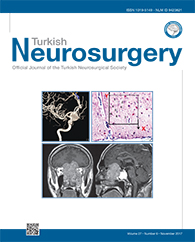2All India Institute of Medical Science, Department of Radiodiagnosis and Imaging, New Delhi, India DOI : 10.5137/1019-5149.JTN.17046-16.1 AIM: Microscope may fail to detect culprit vessel at the root entry zone or distally, especially when the suprameatal tubercle is prominent and when the compressing vessel is lying anteriorly to the trigeminal nerve without using significant brain retraction. Endoscopic techniques allow better visualization of the nerve and vascular conflict.
MATERIAL and METHODS: A retrospective study of 178 patients of endoscopic vascular decompression without the use of microscope was done. The follow-up period ranged from 12 to 108 months (average 58 months).
RESULTS: The age of the patients ranged from 32 to 75 years. Neuralgia was in the maxillary, mandibular and both (maxillary and mandibular) divisions in 89, 72 and 16 patients, respectively. Duration of the operation and hospital stay ranged from 85 to 160 minutes and 2 to 10 days (average 2.7 days), respectively. Offending vessels could be identified in 174 patients. The superior cerebellar artery, anterior inferior cerebellar artery, single vessel, double vessel conflicts and a vessel anterior to the nerve were seen in 136, 76, 133, 41 and 31 patients, respectively. The pain was relieved in 167 patients (93.8%). Temporary complications included trigeminal dysesthesias (3.9%), cerebrospinal fluid leak (2.8%), facial paresis (3.9%), decreased hearing (1.7%) and vertigo (3.3%). Permanent hearing loss, recurrence of pain and re-surgery was observed in 1, 7 and 3 patients, respectively.
CONCLUSION: Endoscopic vascular decompression is a safe and effective technique for vascular decompression with advantages of better visualization of the entire course of the nerve and vascular conflict without brain retraction. It also helps in better detection of the completeness of surgery.
Keywords : Endoscopy, Microvascular decompression surgery, Skull base, Trigeminal neuralgia




